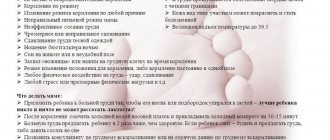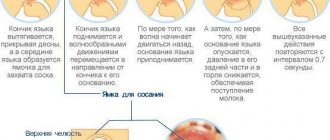Expert: lactation consultant Nina Zaichenko
How often to feed a newborn? This question often arises for a young mother who cannot understand whose advice to follow: modern maternity hospital specialists (who recommend feeding the baby on demand) or mothers and grandmothers who claim that they have always given breast or formula to their baby strictly on time - every three hours, including night feeding, for which the child must be specially woken up.
Some modern mothers prefer to partially follow their grandmother's advice and feed their babies by the hour, but do not wake them up at night, because they believe that a hungry child will wake up at night and, if necessary, ask for food.
Is it possible to overfeed a baby with breast milk? How often should you breastfeed your newborn?
To understand how often to breastfeed your newborn, imagine yourself as a young mother with a baby on a desert island, where you have no concept of time or clock. Would you watch the movement of the sun or calculate the intervals between feedings of your baby? Having answered this question, you will understand that by nature it is in the body to feed the child at his request. And the human body itself is created in such a way that feeding on demand is natural for it and is aimed at maintaining health.
As for the answer to the question “How long to feed a newborn?”, the answer will be simple: until the baby is full.
Why does artificial formula take so long to be absorbed?
Because older generation formulas do not contain enzymes that help breast milk digest itself.
However, science does not stand still, and recently scientists managed to make a discovery that radically changed the possibilities of artificial feeding. This discovery was made while studying the composition of human breast milk, the main secret of which is the so-called breast milk oligosaccharides (HMOs). It was possible to discover HMOs in the composition of mother’s milk in the last century, but they were synthesized (reproduced in the laboratory) only a few years ago. Scientists were able to create artificial oligosaccharides that are absolutely identical to natural ones. And this was a real breakthrough in the use of infant formula, because now this unique component is added to the most modern of them.
Breast milk oligosaccharides are unique bioactive compounds: they help develop the baby’s immune system, protect his body from infections, preventing pathogenic bacteria from multiplying, and “friendly” bacteria (for example, bifidobacteria), on the contrary, help to grow. In addition, oligosaccharides contribute to the development of the baby's brain.
Therefore, answering the question of a modern mother, “How often should I feed my baby with an adapted milk formula and should I feed my baby at night?” WHO recommendations say that bottle-fed babies today can also be fed on demand (that is, when the baby asks to eat). However, this recommendation applies to the use of new generation mixtures. True, the World Health Organization still recommends limiting the amount of formula: that is, giving the child no more than the volume that corresponds to his physiological parameters (weight and age), even if he insists on supplementation. And the amount of formula that the child has not eaten should not be offered to the child by force.
Of course, the best food for a baby is mother's milk, which, as we found out, can be fed to the baby on demand. If you are unable to breastfeed, then the best choice for your baby will be a new generation of formula milk, which is closest to human breast milk. When choosing the most suitable food for your baby, first carefully study the composition of the mixture, paying special attention to the presence of lutein, Omega-3 and Omega-6 polyunsaturated fatty acids, nucleotides, prebiotics and probiotics. If your baby is prone to allergic reactions, choose hypoallergenic infant formula. But in any case, be sure to consult your pediatrician.
Lecture No. 4 Breastfeeding
In 1989, the World Health Organization and the United Nations Children's Fund (UNICEF) issued a joint statement on the role of maternal health services in protecting, promoting and supporting breastfeeding. This statement summarizes the most current scientific knowledge and practical experience on lactation issues in the form of precise, universally acceptable recommendations for the care of mothers before, during pregnancy and after childbirth.
VERY IMPORTANT! WHO expanded recommendations on breastfeeding.
Early breastfeeding within the first hour after birth.
- Learning to latch on correctly includes not only the correct position at the breast, but also the mother's ability to control the baby's behavior at the breast and, if necessary, wean the breast correctly. Correct positioning of the baby at the breast allows the mother to avoid many problems and complications with the breast.
- Avoid feeding the newborn from a bottle or other method before the mother attaches him to the breast, so that the child does not develop an attitude towards any other feeding other than breastfeeding.
- Keeping mother and child together in the same room.
- Exclusive breastfeeding from the first days of a child’s life until 6 months. According to some studies, he can be breastfed until he is 1 year old without harming his health.
- Feeding on baby's demand. It is necessary to put the baby to the breast for any reason, giving him the opportunity to suckle when he wants and as much as he wants. This is necessary not only for satiating the baby, but also for psycho-emotional comfort. For psychological comfort, the baby can be attached to the breast up to 4 times per hour.
- The duration of feeding is regulated by the child: you should not tear the baby off the breast before he releases the nipple on his own if he is holding the breast correctly (and it does not hurt you). If the baby changes position during feeding and takes the breast incorrectly, it is necessary to remove the breast and offer the baby to take it again.
- Night feedings and co-sleeping between mother and child ensure stable lactation and protect a woman from another pregnancy for up to 6 months in 96% of cases. In addition, night feedings are the most complete.
- Exclusion of additional drinking and supplementary feeding of a child up to 6 months. If the baby is thirsty, he should be put to the breast more often. There is no need to add water or other liquids.
- Complete refusal of pacifiers, pacifiers and bottle feeding. If supplementary feeding is necessary, it should only be given from a cup, spoon or pipette. Sometimes one bottle feeding is enough for the baby to stop latching correctly. Each use of the bottle causes confusion in the baby's latching pattern.
- The baby should not be transferred to the second breast before he has suckled the first breast. If the mother rushes to offer the baby the second breast, he will not receive enough late milk, rich in fats, and as a result, the baby may experience digestive problems: lactase deficiency, foamy stools. Prolonged sucking will ensure proper bowel function.
- Avoid washing nipples before and after feeding. Frequent breast washing leads to the removal of the protective layer of fat from the areola and nipple, which leads to the formation of cracks. Breasts should be washed no more than once a day during a hygienic shower. If a woman showers less often, then in this case there is no need for additional breast washing.
- Avoiding additional pumping of milk after each feeding. 2-3 weeks after birth, with properly organized breastfeeding, milk is produced exactly as much as the baby needs, so there is no need to express after each feeding. Pumping is necessary in case of treatment of mastitis, breast engorgement, lack of milk, and in case of forced separation of mother and child.
- Refusal from frequent control weighings of the child after discharge from the parental home, carried out more than once a week. This procedure will not provide information about the nutritional status of the infant. It only irritates the mother, leads to a decrease in lactation and the unreasonable introduction of supplementary feeding.
- Support for mothers who breastfed their children up to 1-2 years of age. Communicating with women who have had positive experiences with breastfeeding helps a new mother gain confidence in her abilities and receive practical advice to help establish breastfeeding. Therefore, new mothers are advised to contact maternal breastfeeding support groups as early as possible.
- Training in child care and breastfeeding techniques is necessary for a modern mother so that she can raise him up to a year without unnecessary hassle and comfortably for herself and her baby. Lactation consultants will help you arrange care for your newborn and teach your mother breastfeeding techniques.
- Continue breastfeeding until the child is 1-2 years old. Breastfeeding only until 1 year is not a physiological period for the cessation of lactation, so both mother and child suffer during weaning.
Basic feeding positions:
- Sitting - “cradle” - the mother sits, the child lies under the breast on her hand, the baby’s neck is in the mother’s elbow, the palm covers the pelvic end of the child or holds the back. The baby's head has the ability to lean back. The second hand supports the chest.
- Sitting - “cross cradle” - the mother sits, the baby lies under the breast on the opposite arm, the head is located between the thumb and forefinger and has the ability to lean back. The second hand supports the chest.
- Sitting - “from the armpit” - the mother sits, the baby lies under the breast, on the side of the mother, on a pillow, the head is located between the thumb and forefinger, the rest of the body is located behind the mother. The second hand supports the chest.
- Sitting - “on a pillow” - like a cradle, only instead of the mother’s hand there is a pillow.
- Lying - “on your side” - (make sure that your mother’s shoulder is not lying on the pillow), two options
- “Lying on the arm” - mother lies on her side, her head on the pillow; the baby lies on the mother’s lower arm, the lower part of the head is in the elbow, and the mother’s upper arm supports the breast.
“Lying next to mom” - mom lies on her side, her head and lower arm are on the pillow (the hand can rest under the pillow); The neck and lower part of the baby's head is located in the palm of the mother's upper hand.
Correct grip (asymmetrical) and its signs:
- the baby is pressed very tightly to the mother (tummy to tummy) - to suck without turning his head to the side
- the child's head is tilted back so that he can open his mouth wide
- the child's chin is pressed to the mother's chest, the nose is free
- Most of the areola is in the baby's mouth
- cheeks puffed out
- the lower lip is turned outward
- the angle between the child's upper and lower lips is large (140 degrees)
- if you move the corner of your mouth, the tongue is visible
“Breastfeeding represents the natural and ideal way of feeding the infant and provides a unique biological and emotional basis for its development.” WHO (World Health Organization)
Indeed, infant formula and even whole cow's milk are able to cover the energy needs of an infant, therefore, there will be no interference with its growth. But breast milk is still better. The first 6 months of a child’s life should be exclusively dairy. And that's why:
- Women's breast milk contains the same type of protein as the baby. It is mainly human alpha-lactalbumin and does not cause allergic reactions. The mixture and cow's milk contain mainly casein, which has pronounced allergenic properties.
- High levels of amino acids such as taurine, cystine and methionine ensure rapid development of the child’s central nervous system.
- The high fat content at the end of feeding acts as a satiety regulator, so breastfed babies do not overeat and can regulate the amount of their food themselves.
- Human milk is rich in polyunsaturated fatty acids, which are important for brain development.
- Beta-lactose is an essential sugar found only in breast milk. Lactose promotes the absorption of iron and calcium, which prevents the development of anemia and rickets.
- The carbohydrate bifidus factor stimulates the colonization of the children's intestines with beneficial bifidobacteria, which prevents the development of dysbiosis. Cow's milk and mixtures based on it contribute to the development of intestinal dysbiosis.
- The vitamins contained in women's breast milk contribute to the harmonious development of the baby.
- Breast milk is rich in calcium, which is essential for bone growth.
- Breast milk is rich in iron, and for better absorption there is a special factor - lactoferrin. If up to 70% of iron is absorbed from human milk, then only about 10% is absorbed from the formula, due to which artificially fed children often suffer from anemia (popularly anemia).
- Breast milk is the only, unique food that can digest itself. Milk contains 19 enzymes that facilitate the work of children's intestines.
- Hormones present in women's breast milk contribute to the development of the child's mental functions. Milk even contains opioid compounds that improve the baby’s mood. There are also hormones - growth inducers.
- Breast milk protects the baby from infections and contributes to the development of children's immunity due to antibodies, lysozyme, complement, lactoperoxidase, macrophages, lymphocytes and leukocytes that kill pathogenic microorganisms and inactivate viruses. Literally, milk is a very powerful and effective medicine.
- Utilization of human milk is close to 100%. Cow - to 90%.
- Breastfeeding helps to establish the closest relationship between mother and child, full of love and harmony.
- Thanks to breastfeeding, the child develops a correct bite and is less likely to develop caries.
- Breastfeeding is also beneficial for the mother; it helps stop postpartum bleeding due to the release of oxytocin and contractions of the uterus.
- Breastfeeding significantly reduces the risk of breast and ovarian cancer.
- Breastfeeding often causes lactational amenorrhea and is therefore a biological method of birth control.
- Breast milk is always ready for use, always fresh, at the optimal temperature, and can be fed in any conditions.
The above is only what is known to humanity. It is difficult to imagine how many other beneficial properties breast milk has that we do not yet know about. Don’t rush to feed your baby formula, try to combine your career and breastfeeding - it’s possible.
LIST OF SUBJECTS IN CASE OF LIMITED BREASTFEEDING:
1. BREAST PUMP – 1 pc. This item is definitely needed. You've probably met breastfeeding moms who say they feel more comfortable expressing by hand. I assure you, these are women who had to express occasionally, very rarely. You will have to pump several times a day, in different conditions, and it is impossible to do this purely physically with your hands. It is quite difficult to maintain the sterility of milk when expressing by hand. You need to remember the rule - from now on until weaning, the breast pump is your best friend and eternal companion! Always, even if you seem to be going back for the next feeding, take your breast pump with you. The breast pump must be the best, the most effective and, as a result, quite expensive. Both a manual breast pump (its advantage is portability) and an electric one (the advantage is the minimum of your effort when expressing) will suit you. If you have to pump very often and have little free time at work, it makes sense to buy two breast pumps to express two breasts at the same time. One of them must be electric, because a woman has a limited number of hands. All items you purchase (breast pump, bottles, pacifiers, sterilizer) should be compatible with each other, so it is wiser to purchase all items from the same manufacturer. 2. GOOD EXPENSIVE BOTTLES, 125-170 grams each - 3-4 pcs. It is from these bottles that the child will eat in your absence, and those who will remain with the child will use them. Therefore, feeding bottles should be comfortable to hold, easy to clean, and have a wide neck. They must be securely closed with a lid. 3. GOOD NIPPLES, with the smallest hole - 1-4 pcs. Bottles without nipples are usually not sold, so when buying bottles, pay attention to what kind of nipples they come with. The nipple should have a wide base, it should imitate a woman's breast. The opening of this nipple should be very small. Attention! No matter how old your baby is, buy the pacifier with the smallest hole. This is the only way you can prevent the baby from possibly refusing to breastfeed. 4. THE CHEAPEST BOTTLES of 125-170 grams - 4-10 pcs. You will need these bottles to store milk supplies in the freezer. There are not so many requirements placed on them, since they will only serve as containers. You can safely throw away the nipples they come with. Storing milk in regular bottles is the cheapest. It is not recommended to freeze milk in glass containers (for example, baby food jars), since milk elements (mainly fats) will irreversibly stick to the glass. 5. HEATER for baby food – 1 pc. Not the most essential purchase. However, it can make the work of those caring for the child easier. Alternatively, use a large glass of hot water. Do not heat milk or any baby food in the microwave. Microwave ovens heat unevenly, and there is a high risk of burns to the oral cavity. 6. STERILIZER – 1 pc. A sterilizer can help mom deal with bottle nipples faster, but is not a huge necessity. With the same result, you can subject the parts of the breast pump, nipples and bottles to boiling for 5 minutes in a very ordinary saucepan. 7. BABY SCALES – 1 pc. But scales, at least at first, will be very useful. With their help, it is easier to find out the average volume of milk your baby eats per feeding (and based on this, how much milk to express for one serving), and also to monitor the adequacy of weight gain. Next, purchase small items: 8. Bra for nursing mothers – 2-4 pcs. 9. Breast pads - packing 10. Brush for washing baby dishes - 1 pc. Etc., right down to ointment for cracks, silicone nipple covers and drinks that increase lactation - but all this as needed. Having calculated how much money it will cost you to buy baby formula throughout the year, you will quickly notice that organizing breastfeeding is certainly not more expensive.
Rules for storing milk:
- You can only use milk expressed with a sterile breast pump.
- Milk can only be stored in sealed packaging; storing milk in open containers is unacceptable.
- shelf life of milk at room temperature (20°C) – 6 hours
- The shelf life of milk in the refrigerator (but not in the door!) is 48 hours
- The shelf life of milk intended for freezing is 24 hours.
- shelf life of milk in a separate freezer (-18°C) is 3 months
- Milk bottles stored in the freezer should be labeled with the date of expression
- The shelf life of milk in a freezer that does not have a separate door is 2 weeks.
- The shelf life of milk in a deep freeze chamber is 6 months.
- milk should be stored in the back of the freezer
- milk should be frozen as soon as possible after expressing
- Before freezing, milk must be cooled in the refrigerator for 1-2 hours
- Once defrosted, milk can be stored in the refrigerator for up to 24 hours.
- Thawed milk cannot be re-frozen
- Unused milk that has been heated once cannot be stored and cannot be used again.
- Do not add warm expressed milk to cold milk; drain these portions when the freshly expressed milk has cooled
- You can add fresh milk to already frozen milk only using the layer-by-layer freezing method. The first portion of milk, say 30 grams, is poured into the bottom of the bottle and frozen. The second portion of milk is pre-cooled in the refrigerator, poured into a bottle, which then must be placed on its side. Thus, fresh milk has minimal contact with frozen milk. The third portion is frozen with the bottle on the other side. The fourth can be poured and frozen by turning the bottle upside down. When using disposable bags instead of bottles, it is impossible to freeze milk using this method.
Ruthlessly pour non-compliant milk down the drain!
Nutrition volume. Often, mothers, even those who do not work, have questions related to the sufficiency of the baby’s nutrition. There are a great many calculation formulas, the simplest of them are given below:
- In the first 10 days of life, a newborn should receive 2% of body weight per day (ml of milk), multiplied by the day of the child’s life.
- Children from 10 days to 2 months should receive ml of milk per day equal to 1/5 of their body weight.
- Children from 2 to 4 months should receive ml of milk per day equal to 1/6 of their body weight.
- Children from 4 to 6 months should receive ml of milk per day equal to 1/7 of their body weight.
- Children from 6 months to one year should receive a volume of food equal to 1 liter.
The most significant criteria for nutritional sufficiency are:
- adequate weight gain
- good mood and health of the child
- clean, pink, velvety skin
- good dream
- number of urinations more than 6 per day
- homogeneous soft stools from 1 to 8 times a day
For many women, lactation is a continuous obstacle course. Either there is too much milk, then there is not enough milk, then the child is not gaining enough, then he refuses the breast, then there are cracks, then lactostasis, then mastitis, then some other disease, then it is necessary to go to work. But the main thing is to always remember that we are jumping along this obstacle course towards a very important goal - the health of the baby.
VERY IMPORTANT TO KNOW! POSSIBLE OBSTACLES DURING BREASTFEEDING:
First reason. LACTATION CRISIS.
The mammary gland of mammals is a very wisely designed organ. Two processes always occur in it simultaneously - stimulation of milk production and suppression of its secretion. Lactopoiesis is aimed at preventing overflow of the gland and stagnation of milk, which can potentially lead to inflammation and the proliferation of pathogenic microbes. You need to remember a simple rule - how much milk is extracted from the mammary gland, so much it will give in the near future. Roughly speaking, if milk is not evacuated for a long time, this serves as a signal to the breast that there is no one else to drink it, that it is no longer needed, and lactation ends or is significantly reduced. The breasts must be regularly drained of milk by any means. The second rule concerns the frequency of application. Each sucking movement sends impulses to the mother’s brain that require the production of prolactin. Therefore, the more often you apply the baby or breast pump, the more prolactin, the more milk. A lactation crisis is a temporary lack of milk. During a crisis, the child behaves restlessly, demands the breast more often, and sleeps poorly. Most often, a crisis occurs in the first month of a baby’s life, at 4 weeks, at 3 months, at 6 months of a child’s life. Many mothers, both working and non-working, encounter it; many introduce formula, believing that the milk has “run out”. This is a big mistake. After introducing the formula, the milk actually disappears and breastfeeding ends. You need to remember that during a lactation crisis, the “loss” of milk is imaginary. It’s just that your child, due to a growth spurt, quite suddenly began to eat more than he ate before. The mammary gland needs some time, from several days to a week, to adapt to the increased demand. Are you experiencing a lactation crisis? Rejoice, your baby is growing very quickly! And do everything to increase milk production:
- have strong faith in your ability to breastfeed;
- attach the baby for any reason, as often as possible;
- try to both be naked during feeding, ensuring skin-to-skin contact;
- organize co-sleeping and night feedings at the slightest request;
- drink more warm liquids, for example, special herbal teas for lactation;
- keep your chest warm;
- eat carrots, walnuts, dill;
- rest more, devote all your time to communicating with your child;
- do not give your child water to drink or supplement him with food; —
- discard the pacifier if you use one;
- brush aside everyone who thinks that you have little milk and are starving the child (believe me, there are such people even among very close people);
ATTENTION! If you have frozen milk, forget about it! Of course, it is very easy to calm the baby down with an additional portion of milk, but this way you will transform the lactation crisis into a true lack of milk - hypogalactia. Get through these few days. A working mother needs to take a few days off in order to implement all of the above, otherwise breastfeeding may be lost forever.
Second reason. BREAST REFUSAL.
The human baby is by nature a very lazy creature. He always looks for the easiest ways to satisfy his needs. That is why, if it is easier and faster for him to suck from a bottle, he will refuse to suck from the breast. Hence the conclusion - you need to organize breastfeeding in such a way that there is nothing sweeter than breasts for a child. Make his life more difficult, make sure that sucking “not from the breast” does not give him much pleasure: it is better to feed the child not from a bottle nipple, but from a syringe or from a spoon (in this case, the baby must be provided with a pacifier to satisfy the sucking reflex). If you bottle feed:
- the nipple should be hard;
- the hole in the nipple should be minimal, milk should only slowly drip from there;
- on the other hand, so that the child does not refuse the bottle, the nipple should have a wide base, imitating a breast;
- the mother should never feed from a bottle; the child must associate it only with the breast;
- the caregiver should feed the baby in any position, but not in the one in which he sucks from the breast;
If a failure does occur:
- take a few days off, you need to be with your child;
- completely stop using a bottle - switch to a syringe, a spoon, from 3 months you can use a soft sippy cup;
- practice co-sleeping;
- try to attach a naked child while also being naked;
- try to put your baby to the breast when he is hungry but in a good mood;
- try to attach the baby at night when he is half asleep;
- you can try to “deceive” the baby using a silicone breast pad;
- don’t force it; if the child refuses, try another time.
Unfortunately, when your baby refuses to breastfeed, a decrease in milk production inevitably follows, even if you are constantly pumping. This is because a breast pump is not able to stimulate milk production as much as your baby's sucking. Therefore, it is important to prevent refusal.
III reason. REFUSE THE BOTTLE.
Many children do not recognize any pacifiers or pacifiers. This problem does not lead to such catastrophic consequences as breast refusal and can be solved simply - such a child needs to be fed from a syringe, spoon or sippy cup.










